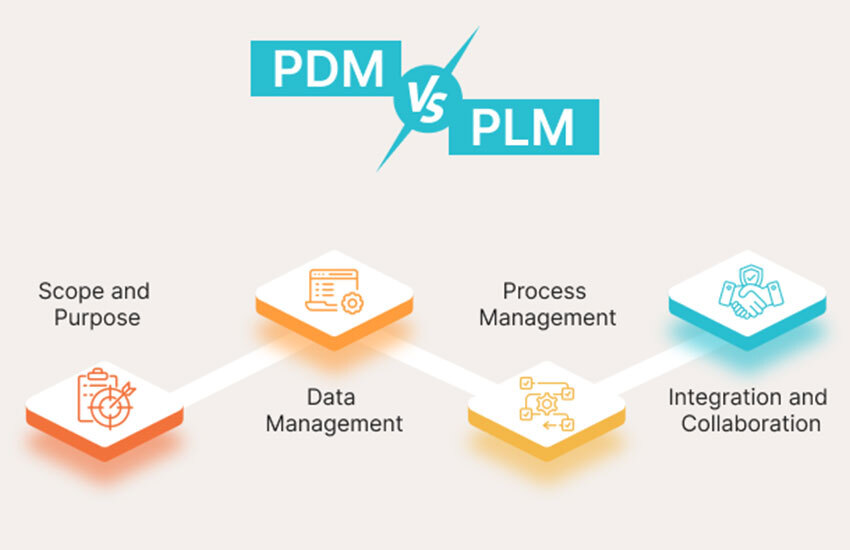
In today's data-driven world, managing product information effectively is critical for businesses of all sizes. The vast amount of data associated with product development, from CAD files to bills of materials (BOMs), can be overwhelming without the right tools. This is where product data management (PDM) and product lifecycle management (PLM) come into play.
While both PDM and PLM deal with product data management, they offer distinct functionalities and cater to different business needs. Thus, understanding these differences is crucial for companies choosing the right data management platform to optimize their product development processes.
So, let us understand each one of it.
PDM software acts as a central hub for managing all design data associated with a product. This includes:
CAD files
3D models
Drawings
Bills of materials (BOMs)
PDM systems offer a range of features to streamline design workflows and improve collaboration within product development teams:
Version Control: Ensures everyone works on the latest version of a file, eliminating confusion and errors due to outdated data.
Secure Access Control: User permissions and access controls prevent unauthorized modifications and data breaches.
Streamlined Collaboration: Facilitates easy sharing and access to files, improving communication and reducing rework.
Workflow Management: Automates workflows for design approvals, change orders, and other processes, streamlining product development.
Improved Search and Retrieval: Makes it easier to find specific files and versions, saving valuable time.
Increased design efficiency and productivity
Reduced errors and rework
Improved communication and collaboration within design teams
Enhanced data security
PDM systems are ideal for companies that primarily focus on managing design data. Following sectors are included in this:
Manufacturing (especially those working with complex CAD models)
Engineering firms
Architectural firms
Product design agencies
Product lifecycle management (PLM) manages data across the complete lifecycle of a product including all the steps from concept to disposal. PLM builds upon the foundation of PDM by incorporating additional functionalities for various departments:
Requirements Management: Capture and track product requirements throughout the development process.
Bill of Materials (BOM) Management: Manage complex BOMs across the entire product lifecycle, including manufacturing and service.
Change Management: Track and manage changes made to the product throughout its lifecycle.
Manufacturing Process Management: Integrate PLM with manufacturing systems to streamline production planning and execution.
Quality Management: Manage quality control processes and track product performance data.
Service Lifecycle Management: Support after-sales processes, including spare parts management and service manuals.
Improved collaboration across all departments involved in the product lifecycle
Enhanced product quality and regulatory compliance
Improved service and maintenance efficiency
Increased visibility into product costs and profitability
Read our comprehensive blog on Revolutionizing Workplace Efficiency with PLM Systems to dive deeper into PLM systems and its advantages.
PLM software is ideal for companies that require a comprehensive view of their product data across the entire lifecycle. Following businesses are included in this:
Aerospace and Defense
Automotive
High-Tech Electronics
Medical Devices
Consumer Goods
The decision between PDM (Product Data Management) and PLM depends on your specific business needs. Here are some key factors to consider using the provided keywords:
Complexity of Products: For businesses with simpler products, Product Data Management software might suffice. PLM systems are more suited for complex products with intricate BOMs and long lifecycles.
Number of Departments Involved: If multiple departments (engineering, manufacturing, marketing, service) need access to product data, PLM's broader capabilities are beneficial.
Data Management Needs: Consider the volume and type of product data you need to manage. PLM systems are better equipped to handle large and complex datasets.
Company Size and Budget: Product Data Management systems (PDM) :typically have lower upfront costs compared to PLM. Take into consideration your budget and the possible return on investment (ROI).
Both PDM and PLM offer valuable solutions for product data management. By understanding the core functionalities and target applications of each system, you can make an informed decision that best fits your business needs.
Additionally, consider these points:
Scalability: Choose a system that can scale with your company's growth.
Integration: Ensure the chosen solution integrates seamlessly with your existing software and systems.
Implementation: Minimize disruption by carefully planning the implementation process.
Modelcam Technologies is a leading provider of PDM and PLM solutions, offering state-of-the-art services to address the unique needs of businesses navigating the complexities of product data management (PDM) and product lifecycle management (PLM). With their expertise in data management software, ModelCam Technologies delivers robust PDM software solutions that empower organizations to efficiently manage their product data, ensuring accuracy, version control, and seamless collaboration among teams.
Additionally, their PLM services encompass a comprehensive suite of tools and functionalities, including project management, quality control, and supplier collaboration, all integrated into a cohesive platform. By leveraging advanced PDM and PLM systems, ModelCam Technologies enables businesses to streamline their product development processes, drive innovation, and achieve competitive advantage in today's dynamic market landscape. Visit their website at Modelcam Technologies to learn more about their PDM and PLM offerings.
Let’s connect: www.modelcamtechnologies.com
Email: sales@modelcamtechnologies.com
Mobile no : +91 8237016167
©Copyright 2025. All rights reserved by Modelcam Technologies Private Limited PUNE.